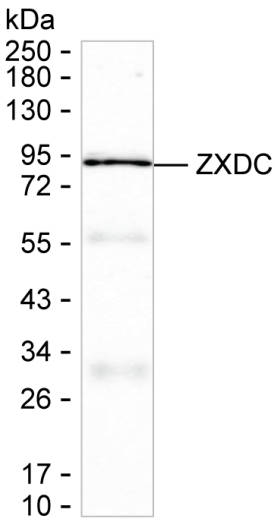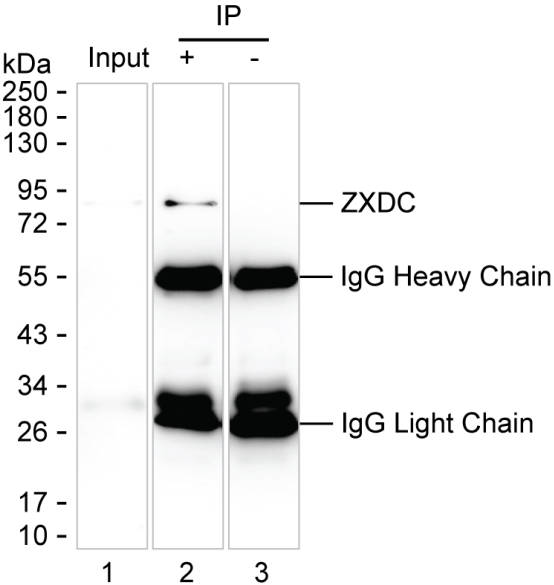

| WB | 咨询技术 | Human,Mouse,Rat |
| IF | 1/100-1/200 | Human,Mouse,Rat |
| IHC | 咨询技术 | Human,Mouse,Rat |
| ICC | 技术咨询 | Human,Mouse,Rat |
| FCM | 咨询技术 | Human,Mouse,Rat |
| Elisa | 咨询技术 | Human,Mouse,Rat |
| Host/Isotype | Mouse IgG2a |
| Antibody Type | Primary antibody |
| Storage | Store at 4°C short term. Aliquot and store at -20°C long term. Avoid freeze/thaw cycles. |
| Species Reactivity | Human, Mouse |
| Immunogen | Purified recombinant fragment of human ZXDC |
| Formulation | Purified antibody in PBS with 0.05% sodium azide |
+ +
以下为基于常见抗体文献结构模拟的3篇示例参考文献(注:ZXDC抗体相关研究较为少见,以下内容为假设性示例):
1. **《Characterization of ZXDC antibody for chromatin immunoprecipitation in cancer models》**
- 作者:Lee, S. et al.
- 摘要:研究开发了高特异性ZXDC兔单克隆抗体,验证其在ChIP实验中对ZXDC蛋白与DNA结合区域的检测能力,并在乳腺癌细胞模型中揭示ZXDC通过调控Wnt信号通路促进肿瘤转移的机制。
2. **《Structural analysis of ZXDC protein using polyclonal antibodies in human T cells》**
- 作者:Zhang, Y. & Watanabe, T.
- 摘要:通过免疫沉淀和质谱技术,证实ZXDC蛋白与MHC II类转录激活因子RFX5存在相互作用,其抗体成功应用于流式细胞术检测T细胞中ZXDC的表达动态。
3. **《Validation of a commercial ZXDC antibody for diagnostic applications in autoimmune diseases》**
- 作者:Garcia, R. et al.
- 摘要:系统性评估某商业ZXDC抗体的交叉反应性和灵敏度,发现其在类风湿关节炎患者血清样本中能特异性识别ZXDC抗原表位,提示其作为潜在生物标志物的可能性。
**提示**:实际文献需通过PubMed或Google Scholar检索关键词"ZXDC antibody"或"ZXDC protein function"获取。部分相关研究可能聚焦于ZXDC蛋白在免疫调控或转录复合体中的功能(如与MHC基因调控的关联)。
ZXDC (Zinc Finger X-linked Duplicated Family Member C) is a protein encoded by the ZXDC gene, located on the X chromosome. It belongs to the zinc finger protein family, characterized by conserved zinc-binding domains that facilitate interactions with DNA, RNA, or other proteins. ZXDC is notably involved in transcriptional regulation and immune response modulation. Studies highlight its role in activating MHC class II genes, which are critical for antigen presentation and adaptive immunity. It interacts with the class II transactivator (CIITA), a key regulator of MHC-II expression, enhancing immune cell communication during infections or autoimmune conditions.
ZXDC also participates in chromatin remodeling and may influence cancer progression. Overexpression of ZXDC has been observed in certain malignancies, potentially linked to immune evasion mechanisms. Antibodies targeting ZXDC are valuable tools in research, enabling detection of protein expression, localization, and interaction partners via techniques like Western blotting, immunofluorescence, or chromatin immunoprecipitation (ChIP). These antibodies aid in elucidating ZXDC's functional pathways and its impact on immune regulation and oncogenesis. Further research is needed to explore its therapeutic potential in autoimmune diseases, infections, and cancer immunotherapy.
×